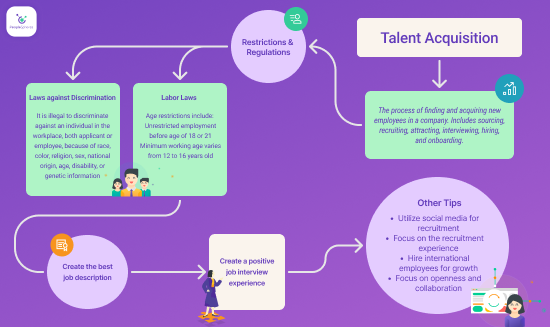-640x380.jpg)
According to a 2022 Gartner study, the workforce is an increasing priority that has been ranked third place as the main concern that CEOs are facing. With a 32% increase, one can tell the shift that companies are now facing toward the importance of human resources and talent acquisition in this day of age.
Talent acquisition is defined as the process of finding and acquiring new employees in a company. It is the first part of talent management and includes sourcing, recruiting, attracting, interviewing, hiring, and onboarding. Keep reading this article as this is your ultimate guide on how to conquer talent acquisition.
Related articles:
7 Best Practices for Hiring International Employees Overseas
High Volume Hiring: Top 5 Strategies for Recruitment
Restrictions and Regulations
Before diving into the talent acquisition process, it is essential that we cover grounds on restrictions and regulations that all talent acquisition teams in the United States need to comply with.
Laws against Discrimination – EEOC
According to laws enforced by Equal Employment Opportunity Commission (EEOC), it is illegal to discriminate against an individual in the workplace, both applicant or employee, because of race, color, religion, sex, national origin, age, disability, or genetic information. During the recruitment process, the talent acquisition team needs to make it clear that they adhere to the laws against discrimination. For example, this can be stated in the job description.
Compliant with Labor Laws
There are also strict rules and laws regarding age restrictions and regulations for hiring new employees. In the majority of states, employees over the age of 18 are unrestricted in employment, with the exception of the tobacco and alcohol industry where employees are normally unrestricted after the age of 21. The minimum working age varies from 12 to 16 years old, and these workers are regulated by various restrictions. If your human resource team is recruiting talent that are legal minors, check with your state’s laws and regulations to ensure that you are complying with labor laws.
Nepotism in the Workplace
Although nepotism in the workplace does not directly violate any labor law, if an employee benefits from knowing a family or friend who is in the company, title v11 of the Civil Rights Act of 1964 can come into play. In some cases, it can become a case of favoritism due to race and/or national origin, which is classified as discrimination. In any case, nepotism in the workplace is considered unethical and can cause problems in your workplace as it is a poor reflection of the company’s priorities, work environment, and business practices.
HR can intervene to help prevent nepotism from happening in their workplace. By adopting solidifying hiring practices within the organization, the HR team can prevent nepotism from happening, rather than fixing it after it has occurred. Make sure that everyone is treated the same during the hiring process, no matter if they are familiar with anyone within the organization or not.
Unconscious Bias
Unconscious bias in HR happens when people make decisions based on stereotypes without realizing it. This can lead to unfair hiring and less diverse workplaces. Try these hiring practices to reduce bias:
- Use blind recruitment (hide names, photos).
- Create diverse hiring panels.
- Train staff to recognize and avoid bias.
- Standardize processes to make decisions fair.
Leaders should promote inclusion and diversity to create a fair environment for everyone.
Conducting a Job Analysis
A job analysis is an essential process, acting as the backbone for various HR activities, especially in talent acquisition. Imagine it as a detailed study of a job role, where the primary goal is to gather systematic information about the duties, responsibilities, necessary skills, outcomes, and work environment of a specific job. It’s like creating a blueprint of what a job entails and what an employee needs to bring to the table to succeed in that role.
When you have a clear, comprehensive job analysis in hand, it becomes much easier to find the right talent. It’s like having a roadmap for recruitment. A job analysis helps in creating accurate job descriptions, which are the first touchpoint for potential candidates. These descriptions, derived from the job analysis, tell candidates what the role involves and what qualifications and skills they need to have. This clarity attracts the right candidate, making the recruitment process more efficient.
Moreover, job analysis doesn’t just help in attracting high quality candidates; it’s also a tool for evaluating them. With a detailed understanding of the job, recruiters and hiring managers can better assess whether a candidate’s abilities and experiences align with the job’s requirements. It’s like having a checklist that you can match against the skills and qualities of applicants. This alignment ensures that the talent you bring on board is not just qualified but also the right person-organization fit.
Create the Best Job Description
The first step to attracting top talent is to elevate your job description. Therefore, it is essential that your HR team writes the perfect job descriptions that stick out from the rest and attract the right job seekers in their search for a new job.
A job description is defined as a document that states the requirements, responsibilities, and skills required for a job role. When creating a job description, consider what potential candidate you want to acquire and make your position description sound exciting and compelling from their perspective. Also, consider these 10 tips:
- Be creative with the title
- Think about your ideal candidate when writing your job description
- Be concise with the job duties
- Only include the most critical skills
- Explain the working relationships
- Let your job description reflect the voice of your company
- Hint on growth and development, if applicable
- Do not add a salary amount
- List the benefits
- End with a proposition
If you follow these tips on how to write a job description, it will increase your chances of finding the perfect candidate for your role.
Create a Positive Job Interview Experience
The job interview is a big part of the recruitment experience as this is the time when your recruiter essentially finds the most qualified hire. The job interview process should be a positive experience for both interviewers and the person being interviewed.
An optimized interview process increases the chances of a positive recruitment experience. There are multiple factors that go into ensuring a successful job interview with an employer.
Before the interview starts, prepare relevant interview questions, and inform the candidates of the topics you will discuss so they will have time to prepare. During the interview, make sure that the interviewer is asking questions in a way that opens for meaningful answers, rather than yes or no responses. After the job interview, make sure to follow up with the candidates regardless of the outcome of the interview.
Talent Acquisition Trends
Are you aware of the latest recruiting trends? This includes the usage of social media, a shift in recruiting strategies, and the utilization of software. As younger generations are entering the workplace, we are seeing new behavior in the search for jobs, such as younger employees using mobile recruiting and social media. As remote work is becoming more prevalent in the business world, it is creating opportunities for recruitment of online jobs, even for international employees. HR software is also becoming an important part of recruitment and hiring, especially talent management software that supports openness and collaboration between business processes.
Utilize Social Media to Recruit Staff
As social media is becoming an important place in our daily lives, more acquisitions coordinators are choosing a modern approach to recruit top talent: recruitment via social media. There are several benefits to utilizing social media to recruit, including reducing the cost of finding new candidates, an increase in jobseekers’ wish to be recruited via social media, and accessibility to reliable information. Social media also makes it possible for you to advertise your job opening on the online job board.
Personalize your recruitment strategy
A successful recruitment strategy should be tailored to the target candidates, considering their career aspirations, preferred work environments, and motivations to ensure the right talent is attracted and engaged effectively.
For example, attracting and retaining top talent for marketing agencies requires developing a compelling employer brand, leveraging digital recruitment channels, emphasizing purpose and impact, showcasing a tech-forward environment, and offering flexible work arrangements.
To appeal to the younger generations, it is significantly beneficial to use social media for recruitment as they are known for mainly using social media as a career site in their job search for relevant openings.
Focus on the Recruitment Experience
If your job candidates have a better recruitment experience with your company compared to others, you have a competitive advantage in acquiring skilled workers. Whether you recruit in-house or utilize a staffing firm, it is important to optimize the entire recruiting process to make the candidate experience as positive as possible.
Kevin Grossman, Talent Board President of Global CandE Programs, stresses the importance of optimized recruiting practices, such as, implementing a reliable recruitingCRM system, as poor recruiting can negatively impact company image and employer brand. He also explains how HR technology and recruiting tools can assist the recruiting and hiring process, as he has identified communication and feedback from pre-application to onboarding as one of the biggest differentiators to improving the recruitment experience.
Inbound vs Outbound Recruitment
Inbound and outbound recruitment are two different approaches to finding talent. Both methods can be effective, depending on the situation and the roles being filled. A combination of the two approaches may be needed to find the right candidate for the role.
- Inbound recruitment focuses on attracting candidates by building a strong employer brand and creating engaging content. It draws candidates in, making them interested in applying on their own.
- Outbound recruitment, on the other hand, is more proactive. Recruiters actively search for and reach out to potential candidates, often through networking, social media, or cold outreach. Utilizing lead enrichment ensures that recruiters have accurate and comprehensive candidate data, allowing for more personalized and effective outreach.
Inbound is about attracting candidates to you, while outbound is about going out and finding them.
Strategies for International Employees
Are you looking to recruit international employees overseas? Remote working has opened up new possibilities for hiring international employees that never have to relocate to work for your company. Hiring international employees to extend business operations beyond US borders is beneficial for both business development and productivity. Naturally, your recruitment strategy is going to be different for international candidates than for your national employees.
To hire employees internationally, it is essential that your human resource management team utilize software that supports international employees. For example, you will be required to add a new language to your HR software or extend your payroll software so it can process payroll in a different currency.
Openness and Collaboration
Lars Schmidt, the co-founder of HR Open Source, has many times stressed the importance of openness and collaboration for HR management practices, talent acquisition included. HR Open Source highlights one of the biggest recruitment trends; open-source approaches in HR and recruiting with the objective of democratizing access to high-value resources, tool kits, templates, and more that streamline HR and talent acquisition practices.
PeopleSpheres is a unified platform that gathers all your HR data and software onto a single platform, permanently removing the headache of dispersed systems and data. PeopleSpheres reduce HR workload and streamline HR tasks for employees, including the recruiting and onboarding process. The cloud-based platform makes it possible to automate recruiters’ tasks through workflows and sort high-volume information in the candidate pool.
High Volume Hiring
High volume hiring is a talent acquisition strategy that allows you to fill a larger amount of positions over a specific time. Contrary to regular recruitment practices, high volume hiring is usually run by a candidate management system with the objective to recruit masses, using technology to support searches of multiple qualified candidates through the talent pool, commonly used for seasonal or entry-level job openings.
High volume hiring enables you to screen and recruit job seekers with timing, with limited time and resources. It is an efficient recruitment strategy for organizations with high turnover environments. However, it is important to maintain relationship management and human interaction as the process is often automated and relies on data, thus can often feel impersonal and worsen the recruiting experience.
Boomerang Employees
Boomerang employees refer to when an employee leaves their job for one another company but ends up returning, wanting their old position back. Previously looked frowned upon by companies, boomerang employees are becoming more common as an increased amount of people are changing jobs more frequently. There are both pros and cons to hiring boomerang employees.
For example, hiring employees that have previously had a job at the workplace typically requires a shorter onboarding and training timeline, however, HR professionals need to be careful to not treat boomerang employees differently during the recruitment process as this can be considered favoritism and can lead to a bad employer reputation.
Conclusion
Talent acquisition is the process of finding and acquiring new hires for a company and includes sourcing, recruiting, attracting, interviewing, hiring, and onboarding. It is essential that all HR professionals follow restrictions and regulations regarding talent acquisition, such as laws against discrimination and age restrictions. To optimize your talent acquisition practices, make sure that your HR department prioritizes creating the best job description, considers utilizing social media for recruiting, focuses on the recruitment process, optimizes the interview process, and considers using recruiting software. The usage of recruitment software is particularly important to optimize talent acquisition practices.





-640x380.jpg)
